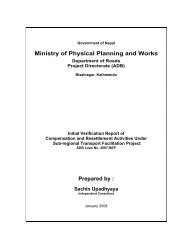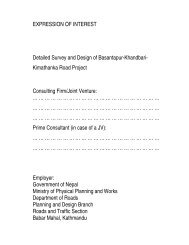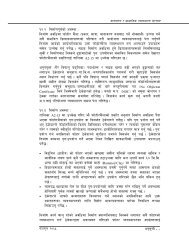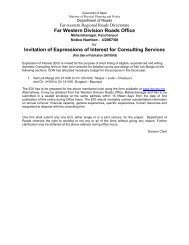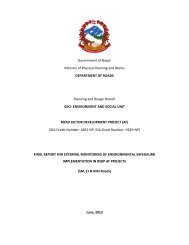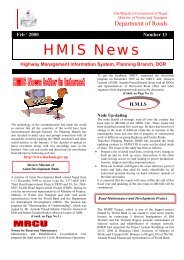NEPAL VEHICLE OPERATING COSTS - About Department of Road
NEPAL VEHICLE OPERATING COSTS - About Department of Road
NEPAL VEHICLE OPERATING COSTS - About Department of Road
Create successful ePaper yourself
Turn your PDF publications into a flip-book with our unique Google optimized e-Paper software.
Working Paper – Vehicle Operating Costs Page 5<br />
Table 4: Bus Operating Costs and Revenues on a per km basis<br />
Fuel<br />
Oil<br />
Tyres<br />
Maintenance<br />
Crew<br />
Direct costs<br />
Depreciation<br />
Interest<br />
Overheads<br />
Total Operating Costs<br />
Revenue<br />
Bus Survey<br />
N Rs /km<br />
8.809 (median)<br />
-<br />
-<br />
2.018 (median)<br />
2.892 (median)<br />
-<br />
-<br />
-<br />
21.1 to 23.3<br />
VOC model<br />
N Rs / km<br />
6.836<br />
0.626<br />
1.417<br />
1.477<br />
3.174<br />
13.530<br />
2.351<br />
1.571<br />
1.151<br />
18.603<br />
An exact comparison with the VOC model was not as easy to achieve, compared with<br />
the trucks, because <strong>of</strong> the more varied nature <strong>of</strong> the bus operations surveyed. Bus trip<br />
lengths were longer as many buses travelled on routes to west and east Nepal where<br />
road roughness is higher than on the main truck route to Birgunj. The higher, than<br />
predicted, maintenance and fuel costs may be explained, in part, by this difference in<br />
road conditions. The components that do not vary directly with travel (ie. Crew,<br />
depreciation, interest, overheads ) are higher for buses than for trucks because <strong>of</strong> the<br />
lower levels <strong>of</strong> utilisation.<br />
In Nepal the Tata trucks and buses are based on a very similar vehicle type and it is to<br />
be expected that the model relationships used should be fairly similar because the<br />
vehicle and the component parts are very similar and have similar prices. However<br />
differences in operating costs can arise not only from the different road conditions but<br />
from the different driving behaviour and different vehicle loading. Buses tend to drive<br />
faster while trucks are much more heavily loaded.<br />
Overall it was felt that there was insufficient basis to change the bus VOC<br />
relationships. However it is recommended that the changes relating to oil<br />
consumption and tyres for trucks should also be applied to buses. New utilisation<br />
rates and VOC prices should also be applied.<br />
4. OUTSTANDING ISSUES<br />
It should be recognised that considerable uncertainty still exists on the nature <strong>of</strong> VOC<br />
relationships in Nepal. This is particularly the case for how VOCs behave on rougher<br />
roads and roads with more extreme gradient and curvature. If possible research<br />
should be carried out to check how fuel consumption, tyre wear and maintenance<br />
costs vary away from the main road network. The Indian VOC relationships show



![j:6 ]zg cfof ]hgf](https://img.yumpu.com/51286794/1/190x245/j6-zg-cfof-hgf.jpg?quality=85)

![x'nfsL /fhdfu { cfof ]hgf](https://img.yumpu.com/50581959/1/190x245/xnfsl-fhdfu-cfof-hgf.jpg?quality=85)

